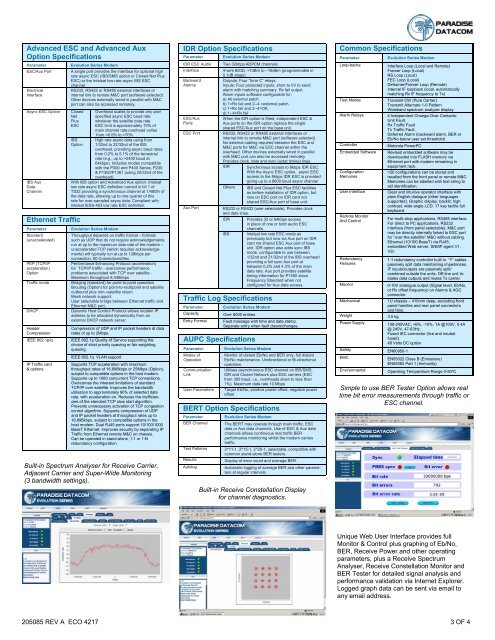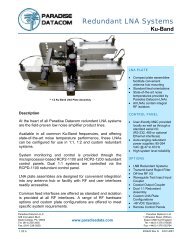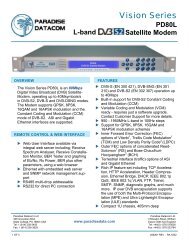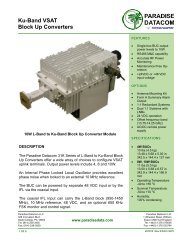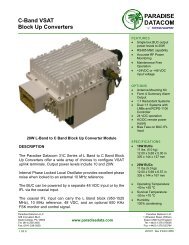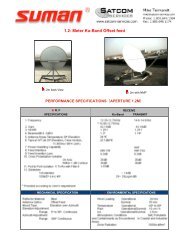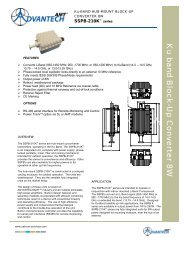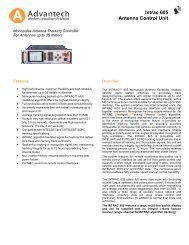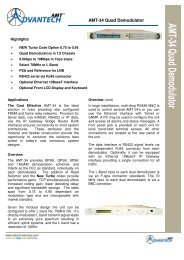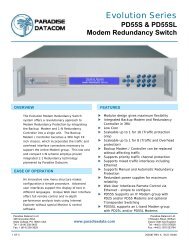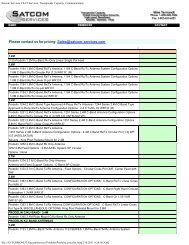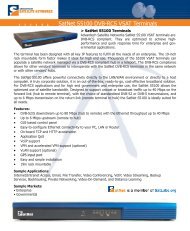PD25 IF Satellite Modem - Satcom Services
PD25 IF Satellite Modem - Satcom Services
PD25 IF Satellite Modem - Satcom Services
Create successful ePaper yourself
Turn your PDF publications into a flip-book with our unique Google optimized e-Paper software.
Advanced ESC and Advanced Aux<br />
Option Specifications<br />
Parameter<br />
ESC/Aux Port<br />
Electrical<br />
Interface<br />
Async ESC Option<br />
IBS Aux<br />
Data<br />
Channel<br />
Evolution Series <strong>Modem</strong><br />
A single port provides the interface for optional high<br />
rate async ESC (IBS/SMS option or Closed Net Plus<br />
ESC) or the Intelsat low rate async IBS ESC<br />
channel.<br />
RS232, RS422 or RS485 external interfaces or<br />
internal link to remote M&C port (software selected).<br />
Other devices externally wired in parallel with M&C<br />
port can also be accessed remotely.<br />
Closed<br />
Net<br />
Plus<br />
ESC<br />
IBS<br />
Option<br />
Ethernet Traffic<br />
Parameter<br />
Standard<br />
(unaccelerated)<br />
PEP (TCP/IP<br />
acceleration)<br />
Option<br />
Traffic mode<br />
DHCP<br />
Header<br />
Compression<br />
IEEE 802.1p/q<br />
IP Traffic card<br />
& options<br />
Overhead scales to provide any user<br />
specified async ESC baud rate<br />
whatever the satellite data rate.<br />
ESC limit is approximately 70% of<br />
main channel rate,overhead varies<br />
from 70%.<br />
High rate async data using from<br />
1/32nd to 22/32nd of the IBS<br />
overhead, providing async baud rates<br />
from 0.2% to 5.1% of the terrestrial<br />
rate (e.g., up to >2400 baud at<br />
64kbps). Includes modes compatible<br />
with the P300 and P400 Series, P230<br />
& P1300/P1361 (using 20/32nd of the<br />
overhead).<br />
With IBS option and Advanced Aux option: Intelsat<br />
low rate async ESC definition carried in bit 1 of<br />
TS32 providing a synchronous channel at 1/480th of<br />
the data rate, allowing up to one quarter of this<br />
rate for over-sampled async data. Compliant with<br />
Intelsat IESS-403 low rate ESC definition.<br />
Evolution Series <strong>Modem</strong><br />
Throughput depends on traffic format – formats<br />
such as UDP that do not require acknowledgements<br />
run at up to the maximum data rate of the modem –<br />
unaccelerated TCP (which requires acknowledgements)<br />
will typically run at up to 128kbps per<br />
connection, 80 Connections/Sec<br />
Performance Enhancing Protocol (acceleration)<br />
for TCP/IP traffic - overcomes performance<br />
problems associated with TCP over satellite .<br />
Maximum throughput 8,448kbps<br />
Bridging (standard) for point-to-point operation<br />
Brouting (Option) for point-to-multipoint and satellite<br />
outbound plus non--satellite return.<br />
Mesh network support.<br />
User selectable bridge between Ethernet traffic and<br />
Ethernet M&C port.<br />
Dynamic Host Control Protocol allows modem IP<br />
address to be allocated dynamically from an<br />
external DHCP network server.<br />
Compression of UDP and IP packet headers at data<br />
rates of up to 2Mbps.<br />
IEEE 802.1p Quality of Service supporting the<br />
choice of strict priority queuing or fair weighting<br />
queuing.<br />
IEEE 802.1q VLAN support<br />
Supports TCP acceleration with maximum<br />
throughput rates of 16,896kbps or 25Mbps (Option),<br />
subject to compatible options in the host modem.<br />
Supports up to 1000 concurrent TCP connections.<br />
Overcomes the inherent limitations of standard<br />
TCP/IP over satellite. Improves the bandwidth<br />
utilisation to approximately 90% of selected data<br />
rate, with acceleration on. Reduces the inefficiencies<br />
of the standard TCP slow start algorithm.<br />
Prevents unnecessary activation of TCP congestion<br />
control algorithm. Supports compression of UDP<br />
and IP packet headers at throughput rates up to<br />
16,896kbps, subject to compatible options in the<br />
host modem. Dual RJ45 ports support 10/100/1000<br />
BaseT Ethernet. Improves security by separating IP<br />
Traffic from Ethernet remote M&C on chassis.<br />
Can be operated in stand-alone, 1:1 or 1:N<br />
redundancy configuration.<br />
Built-in Spectrum Analyser for Receive Carrier,<br />
Adjacent Carrier and Super-Wide Monitoring<br />
(3 bandwidth settings).<br />
IDR Option Specifications<br />
Parameter<br />
IDR ESC Audio<br />
Interface<br />
Backward<br />
Alarms<br />
ESC/Aux<br />
Ports<br />
ESC Port<br />
Aux Port<br />
Evolution Series <strong>Modem</strong><br />
Two 32kbps ADPCM channels<br />
4-wire 600Ω, +7dBm to –16dBm (programmable in<br />
0.1dB steps).<br />
Outputs: Four “form C” relays.<br />
Inputs: Four protected inputs, short to 0V to send<br />
alarm with matching summary Rx fail output.<br />
Alarm inputs software configurable for:<br />
a) All external patch,<br />
b) 1=Rx fail and 2--4 =external patch,<br />
c) 1=Rx fail and 2--4=OK,<br />
d) 1--4=Rx fail<br />
When the IDR option is fitted, independent ESC &<br />
Aux ports on the IDR option replace the single<br />
shared ESC/Aux port on the base unit.<br />
RS232, RS422 or RS485 external interfaces or<br />
internal link to remote M&C port (software selected).<br />
No external cabling required between the ESC and<br />
M&C ports for M&C via ESC channel within the<br />
overhead. Other devices externally wired in parallel<br />
with M&C port can also be accessed remotely.<br />
Provides clock, data and sync (octet timing) lines.<br />
IDR Synchronous access to 8kbps IDR ESC.<br />
With the Async ESC option, async ESC<br />
access to the 8kbps IDR ESC is provided<br />
giving up to a 9600 baud async channel<br />
Others IBS and Closed Net Plus ESC facilities<br />
as before installation of IDR option, but<br />
now on ESC port on IDR card not<br />
shared ESC/Aux port of base unit.<br />
RS232 or RS422 (user selectable). Provides clock<br />
and data lines.<br />
IDR<br />
IBS<br />
Traffic Log Specifications<br />
Parameter<br />
Capacity<br />
Entry Format<br />
AUPC Specifications<br />
Parameter<br />
Modes of<br />
Operation<br />
Communication<br />
Link<br />
User Parameters<br />
Provides 32 or 64kbps access<br />
in place of one or both audio ESC<br />
channels.<br />
Intelsat low rate ESC mode as<br />
previously but now via Aux port on IDR<br />
card not shared ESC Aux port of base<br />
unit. IDR option also adds sync IBS<br />
mode, configurable to use between<br />
1/32nd and 21/32nd of the IBS overhead<br />
providing a full sync Aux port at<br />
between 0.2% and 4.3% of the main<br />
data rate. Aux port provides satellite<br />
timing information for P1500 slave<br />
Frequency Standard when not<br />
configured for Aux data access.<br />
Evolution Series <strong>Modem</strong><br />
Over 6000 entries<br />
Fault message with time and date stamp.<br />
Separate entry when fault clears/changes.<br />
Evolution Series <strong>Modem</strong><br />
Monitor of distant Eb/No and BER only, full distant<br />
Eb/No maintenance. Unidirectional or Bi-directional<br />
operation.<br />
Utilises asynchronous ESC channel on IBS/SMS,<br />
IDR and Closed Network plus ESC carriers (ESC<br />
from 300 baud, i.e., overheads down to less than<br />
1%). Maximum data rate 10 Mbps<br />
Target Eb/No, positive power offset, negative power<br />
offset<br />
BERT Option Specifications<br />
Parameter<br />
BER Channel<br />
Test Patterns<br />
Results<br />
Autolog<br />
Evolution Series <strong>Modem</strong><br />
The BERT may operate through main traffic, ESC<br />
data or Aux data channels. Use of ESC & Aux data<br />
channels allows continuous real traffic BER<br />
performance monitoring whilst the modem carries<br />
traffic.<br />
2^11-1, 2^15-1, 2^20-1, selectable, compatible with<br />
common stand-alone BER testers.<br />
Display of error count and average BER.<br />
Automatic logging of average BER and other parameters<br />
at regular intervals.<br />
Built-in Receive Constellation Display<br />
for channel diagnostics.<br />
Common Specifications<br />
Parameter<br />
Loop-backs<br />
Test Modes<br />
Alarm Relays<br />
Controller<br />
Embedded Software<br />
Configuration<br />
Memories<br />
User Interface<br />
Remote Monitor<br />
And Control<br />
Redundancy<br />
Features<br />
Monitor<br />
Mechanical<br />
Weight<br />
Power Supply<br />
Safety<br />
EMC<br />
Environmental<br />
Evolution Series <strong>Modem</strong><br />
Interface Loop (Local and Remote)<br />
Framer Loop (Local)<br />
RS Loop (Local)<br />
FEC Loop (Local)<br />
Deframer/Framer Loop (Remote)<br />
Internal <strong>IF</strong> loopback (local, automatically<br />
matching Rx <strong>IF</strong> frequency to Tx)<br />
Transmit CW (Pure Carrier)<br />
Transmit Alternate 1-0 Pattern<br />
Wideband spectrum analyzer display<br />
4 Independent Change-Over Contacts:<br />
Unit Fault,<br />
Rx Traffic Fault<br />
Tx Traffic Fault,<br />
Deferred Alarm (backward alarm, BER or<br />
Eb/No below user set threshold)<br />
Motorola PowerPC<br />
Revised embedded software may be<br />
downloaded into FLASH memory via<br />
Ethernet port with modem remaining in<br />
equipment rack.<br />
>20 configurations can be stored and<br />
recalled from the front panel or remote M&C.<br />
Memories can be labelled with text string to<br />
aid identification.<br />
Clear and intuitive operator interface with<br />
plain English dialogue (other languages<br />
supported). Graphic display, backlit, high<br />
contrast, wide angle LCD. 17 key tactile full<br />
keyboard.<br />
For multi-drop applications, RS485 interface.<br />
For direct to PC applications, RS232<br />
interface (front panel selectable). M&C port<br />
may be directly internally linked to ESC port<br />
for “over-the-satellite” M&C without cabling.<br />
Ethernet (10/100 BaseT) via RJ45,<br />
embedded Web server, SNMP agent V1,<br />
V2c<br />
1:1 redundancy controller built in. “Y” cables<br />
passively split data maintaining impedances.<br />
<strong>IF</strong> inputs/outputs are passively split/<br />
combined outside the units. Off-line unit tristates<br />
data outputs and mutes Tx carrier.<br />
0-10V analogue output (Signal level, Eb/No,<br />
or Rx offset frequency) on Alarms & AGC<br />
connector.<br />
1U chassis – 410mm deep, excluding front<br />
panel handles and rear panel connectors<br />
and fans.<br />
3.5 kg<br />
100-240VAC, +6%, -10%, 1A @100V, 0.4A<br />
@ 240V, 47-63Hz.<br />
Fused IEC connector (live and neutral<br />
fused).<br />
48 Volts DC option<br />
EN60950-1<br />
EN55022 Class B (Emissions)<br />
EN55082 Part 1 (Immunity)<br />
Operating Temperature Range 0-50ºC<br />
Simple to use BER Tester Option allows real<br />
time bit error measurements through traffic or<br />
ESC channel.<br />
Unique Web User Interface provides full<br />
Monitor & Control plus graphing of Eb/No,<br />
BER, Receive Power and other operating<br />
parameters, plus a Receive Spectrum<br />
Analyser, Receive Constellation Monitor and<br />
BER Tester for detailed signal analysis and<br />
performance validation via Internet Explorer.<br />
Logged graph data can be sent via email to<br />
any email address.<br />
205085 REV A ECO 4217 3 OF 4


